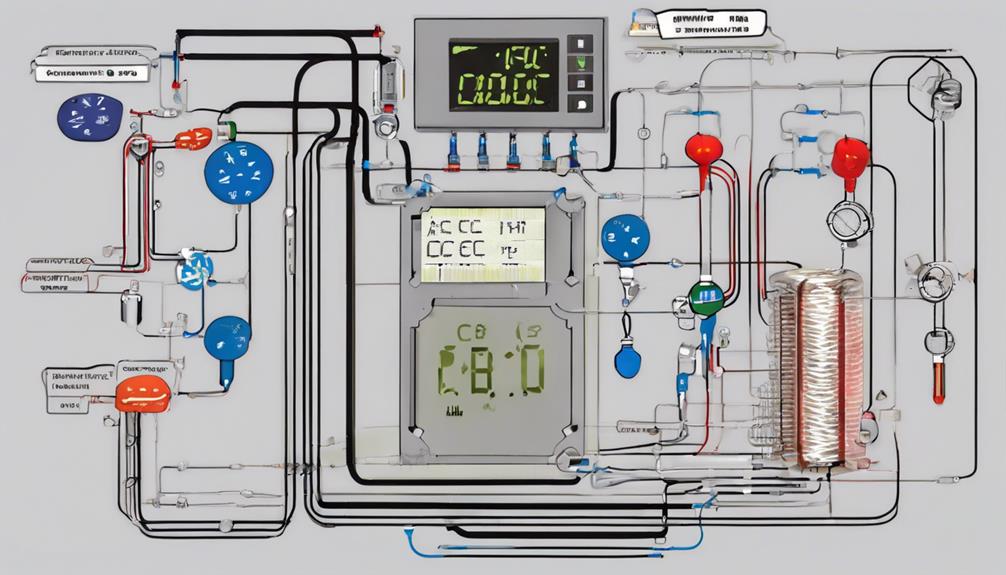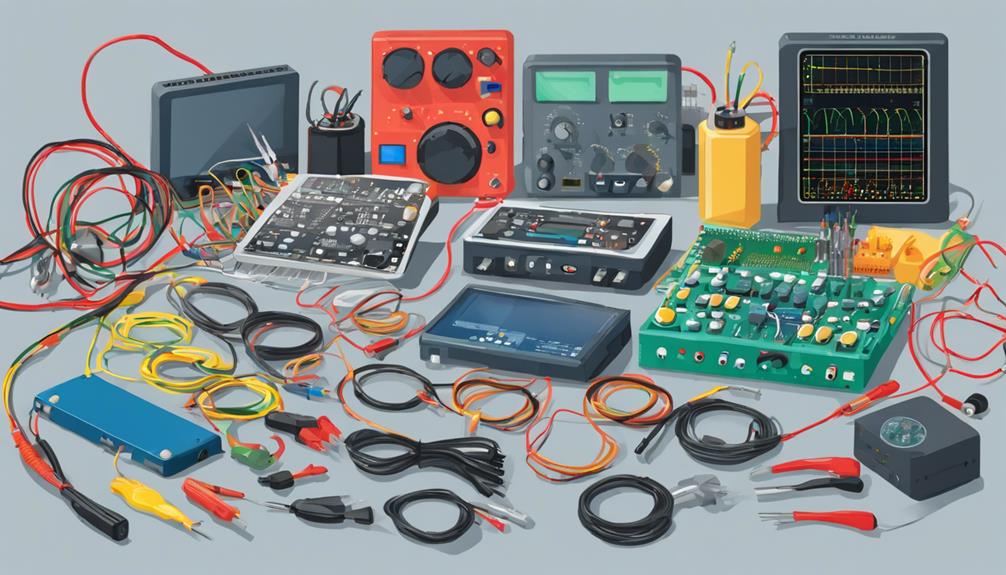To guarantee the reliability of Printed Circuit Board Assemblies (PCBAs), a thorough testing strategy involving multiple methods is essential. Seven effective methods for reliability analysis are Accelerated Life Testing (ALT) Method, Failure Modes and Effects Analysis (FMEA), Highly Accelerated Life Testing (HALT) Method, Temperature Cycling Testing Method, Environmental Stress Screening (ESS) Method, Burn-In and Temperature Testing, and In-Circuit Testing and Inspection. Each method targets specific aspects of PCBA reliability, from identifying potential failure modes to detecting latent defects. By combining these methods, manufacturers can enhance overall PCBA reliability and, subsequently, prevent product failures.
Key Takeaways
- Accelerated Life Testing (ALT) and Highly Accelerated Life Testing (HALT) methods predict reliability through accelerated stress conditions and identify potential failure modes.
- Temperature Cycling Testing simulates real-world thermal stress to evaluate reliability under varying thermal conditions and identify potential failures.
- Failure Modes and Effects Analysis (FMEA) classifies failure modes, identifies potential failure risks, and enhances reliability through proactive design improvements.
- Environmental Stress Screening (ESS) and Burn-In testing detect weaknesses and latent defects early in the design phase, reducing the risk of costly rework.
- In-Circuit Testing and Inspection verifies component placement, ensures polarity correctness, and detects defects early, enabling cost-effective corrections.
Accelerated Life Testing (ALT) Method
Accelerated Life Testing (ALT) is an essential method for evaluating the reliability of PCBA designs by subjecting them to accelerated stress conditions that simulate aging and predict reliability. This method is vital for evaluating and predicting PCBA reliability under extreme conditions.
By estimating expected life through failure rate analysis and extrapolation, ALT determines life expectancy, enabling designers to make informed decisions. ALT is effective in identifying potential failure modes early on, allowing for improvements to design reliability.
By determining operational limits and failure modes, ALT enhances the overall reliability of PCBA designs. Through ALT, designers can identify and mitigate potential failures, reducing the risk of costly redesigns and improving overall product reliability.
Failure Modes and Effects Analysis (FMEA)

In the context of PCBA reliability analysis, Failure Modes and Effects Analysis (FMEA) is an essential methodology that involves identifying and classifying potential failure modes, as well as evaluating their effects on overall system reliability.
To effectively implement FMEA, a systematic approach is necessary, comprising failure mode classification and effects analysis methodology.
Failure Mode Classification
PCBA designers and manufacturers employ Failure Modes and Effects Analysis (FMEA) as a systematic method to identify potential failure modes, their causes, and effects on PCBA reliability. FMEA enables the classification of failure modes based on their severity, likelihood, and detectability, allowing for targeted mitigation strategies.
| Failure Mode Classification | Description |
|---|---|
| Critical Failure Modes | High-impact failure modes requiring immediate attention and mitigation strategies. |
| Major Failure Modes | Failure modes with significant impact on PCBA reliability, requiring design changes and process improvements. |
| Minor Failure Modes | Failure modes with minimal impact on PCBA reliability, requiring monitoring and continuous improvement. |
Effects Analysis Methodology
The Failure Modes and Effects Analysis (FMEA) methodology provides a structured approach to identifying and mitigating potential failure risks in PCBA design, enabling manufacturers to enhance reliability through proactive design improvements.
By applying FMEA, designers can systematically identify potential failure modes and their effects on PCBA reliability. This method assesses the severity, likelihood, and consequences of failure modes, allowing for the prioritization of design improvements. FMEA aids in selecting appropriate mitigation measures to enhance PCBA reliability based on identified failure mechanisms.
Through this methodology, manufacturers can proactively address potential failure risks, improving design robustness and enhancing overall reliability.
By identifying and mitigating potential failures, FMEA facilitates the development of more reliable PCBAs, reducing the likelihood of failures during testing and in the field.
Highly Accelerated Life Testing (HALT) Method

The Highly Accelerated Life Testing (HALT) method is an essential tool for PCBA reliability analysis. It enables the identification of failure modes and weaknesses through accelerated stress testing. By subjecting PCBAs to extreme environmental conditions, HALT facilitates the detection of potential faults and flaws, allowing for targeted improvements.
Through environmental stress screening and failure mode identification, HALT provides valuable insights into PCBA reliability. This enables the development of more robust and reliable products.
Environmental Stress Screening
Frequently, designers and manufacturers employ Environmental Stress Screening, specifically the Highly Accelerated Life Testing (HALT) method, to push printed circuit board assemblies (PCBAs) to their operational limits and uncover design vulnerabilities. This approach helps to identify weaknesses in the design, guaranteeing that only robust and reliable designs move forward for production.
HALT testing is a vital step in the PCBA testing process, as it accelerates the life cycle of the product, simulating real-world environmental conditions to detect potential failures. By subjecting PCBAs to extreme stresses, HALT testing ensures that design flaws are identified early, reducing the risk of costly rework and improving overall PCBA reliability.
Key benefits of Environmental Stress Screening using HALT include:
- Improved design reliability: HALT testing pushes components to their limits, identifying potential failure modes and enhancing overall design reliability.
- Accelerated life testing: HALT simulates years of operational life in a matter of hours, reducing the time and cost associated with traditional testing methods.
- Thermal analysis: HALT testing includes thermal shock and thermal analysis to identify thermal-related failures.
- Design for reliability: HALT testing helps designers create more reliable products by identifying and addressing potential weaknesses early in the design phase.
Failure Mode Identification
Through the HALT method, PCBA manufacturers can pinpoint potential failure modes by subjecting the assembly to extreme environmental stressors, thereby identifying vulnerabilities that might otherwise remain hidden.
This accelerated life testing (HALT) approach exposes the PCBA to extreme stress conditions, pushing components to their limits to identify design weaknesses and operational limits.
By subjecting the PCBA to environmental stresses beyond normal operating limits, manufacturers can determine failure modes, enhancing design reliability.
Thermal analysis and PCB failure analysis are integral components of HALT, providing valuable insights into the PCBA's response to extreme conditions.
Stress testing under HALT conditions helps identify potential failure modes, allowing manufacturers to refine their designs and improve overall reliability.
By pushing the PCBA to extreme environmental conditions, manufacturers can identify design flaws and weaknesses, ultimately leading to more reliable and robust products.
Effective failure mode identification through HALT enables manufacturers to optimize their designs, ensuring the production of high-quality, reliable PCBAs.
Temperature Cycling Testing Method

Subjecting PCBAs to repeated temperature fluctuations, temperature cycling testing simulates real-world thermal stress to evaluate reliability under varying thermal conditions. This method is essential for evaluating the reliability of PCBAs under thermal stress, which can cause failures due to thermal expansion and contraction.
Temperature cycling testing is a common practice to simulate real-world temperature fluctuations that PCBAs may experience. By exposing PCBAs to thermal stress, this method helps in predicting and preventing failures related to temperature changes.
Here are some key aspects of temperature cycling testing:
- Identifies potential failures:
Temperature cycling testing helps identify potential failures caused by thermal expansion and contraction in PCBAs.
- Assesses reliability:
This method is vital for evaluating the reliability of PCBAs under varying thermal conditions.
- Simulates real-world conditions:
Temperature cycling testing simulates real-world temperature fluctuations that PCBAs may experience.
- Predicts and prevents failures:
Environmental Stress Screening (ESS) Method

Beyond temperature cycling testing, another critical method for evaluating PCBA reliability is Environmental Stress Screening (ESS), which involves subjecting PCBA units to environmental stresses like temperature, vibration, and humidity to identify latent defects before shipment. This manufacturing process is designed to eliminate defects and improve the reliability of PCBA units.
ESS is an essential step in ensuring the reliability of PCBA units by identifying potential failures early in the manufacturing process. By subjecting units to environmental stresses, manufacturers can screen out weak units that may fail in the field, thereby enhancing the overall reliability of their products.
| Environmental Stress | Purpose | Benefits |
|---|---|---|
| Temperature | Identify temperature-related defects | Improves reliability, reduces field failures |
| Vibration | Identify vibration-related defects | Enhances product durability |
| Humidity | Identify humidity-related defects | Reduces warranty claims |
Burn-In and Temperature Testing

In the pursuit of ensuring PCBA reliability, Burn-In and Temperature testing emerge as vital methods for identifying latent defects and evaluating performance under thermal stress.
Burn-In testing involves subjecting PCBA to elevated temperatures and operational stresses for an extended period to identify latent defects. This method helps detect infant mortality failures by stressing components at high temperatures before deployment.
On the other hand, Temperature testing assesses PCBA reliability under varying temperature conditions to guarantee components can withstand thermal stress.
The benefits of Burn-In and Temperature testing can be summarized as follows:
- Detection of latent defects: Burn-In testing identifies defects that may not be apparent during initial testing.
- Evaluation of thermal stress: Temperature testing ensures PCBA performance in extreme temperature ranges.
- Prevention of premature failures: Both methods help prevent premature failures in the field by identifying and addressing defects early on.
- Enhanced PCBA reliability: Burn-In and Temperature testing are essential for ensuring the reliability of PCBAs in harsh environments.
In-Circuit Testing and Inspection

As an essential step in the PCBA testing process, In-Circuit Testing (ICT) enables the verification of component placement, polarity, and functionality on assembled PCBAs, detecting defects and guaranteeing compliance with design specifications and quality standards. This testing method utilizes bed-of-nails fixtures to test components without powering on the board, allowing for the detection of component defects such as shorts, opens, and incorrect values.
ICT is a critical failure analysis technique, as it can identify defects early in the production process, enabling cost-effective corrections before deployment. By guaranteeing PCBAs meet design specifications and quality standards, ICT plays a crucial role in reliability analysis.
| ICT Benefits | Defect Detection | Advantages |
|---|---|---|
| Verifies component placement | Shorts, opens, incorrect values | Early defect detection |
| Ensures polarity correctness | Component defects | Cost-effective corrections |
| Tests functionality | Improved reliability | |
| Compliance with standards | ||
| Reduced production costs |
Frequently Asked Questions
What Is a Reliability Test for Pcba?
A reliability test for PCBA is a systematic evaluation of a printed circuit board assembly's ability to operate within specified parameters over its intended lifespan.
This assessment simulates real-world environmental stresses, such as temperature fluctuations, vibration, and humidity, to identify potential failure modes, weak components, and design flaws.
What Are the 7 Types of PCB Testing Methods?
Like a master weaver, the PCB testing process interlaces multiple threads of evaluation to create a tapestry of reliability.
The 7 types of PCB testing methods form the fabric of this assessment.
Mechanical testing probes structural integrity, while thermal testing evaluates performance under varied temperatures.
Electrical testing scrutinizes connectivity, vibration testing simulates real-world conditions, and environmental testing assesses resistance to moisture and humidity.
Chemical and ionizing radiation testing complete the thorough evaluation of PCB reliability.
Which Method Is Used for PCB Board Testing?
For PCB board testing, multiple methods are employed to guarantee reliability and detect defects. Automated Optical Inspection (AOI) is commonly used to detect defects like missing components or misalignments.
Additionally, In-Circuit Testing (ICT) is utilized for functional testing and verifying component placement and solder joint quality.
These methods are vital in identifying defects and ensuring the reliability of PCB assemblies.
What Maximizes the Effectiveness of Testing a Pcb?
Performing a thorough array of tests is vital to maximize the effectiveness of testing a PCB. This involves mechanical, thermal, electrical, and environmental stress testing to identify potential failures and weaknesses.


